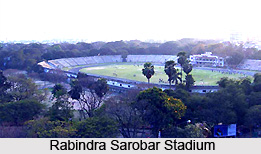 Rabindra Sarobar is an artificial lake, which is also called the Dhakuria Lake situated in south Kolkata. It is set amidst the city`s busy roads and gives a chance to the inhabitants for some recreational pleasure. Rabindra Sarobar has a history attached with it, and it was renamed in May 1958 as a tribute to Rabindra Nath Tagore.
Rabindra Sarobar is an artificial lake, which is also called the Dhakuria Lake situated in south Kolkata. It is set amidst the city`s busy roads and gives a chance to the inhabitants for some recreational pleasure. Rabindra Sarobar has a history attached with it, and it was renamed in May 1958 as a tribute to Rabindra Nath Tagore.
The Lake came into being with the effort of the Calcutta Improvement Trust (CIT), a body responsible for developmental work in the Kolkata metropolitan area. They possessed 192 acres of marshy jungles in order to develop the area for residential purposes, along with construction of roads, parks and lakes for the areas improvement. From this venture the lake came into existence, which is very well known and famous in south Kolkata. The area, which surrounds the excavated lake, was later utilized and transformed into children`s parks, gardens and auditorium. The place not only is utilized by the people for leisurely activities it attracts every morning loads of exercise freaks and joggers.
The lake area is 73 acres, which is covered by water, while shrubs and trees cover the rest of the area. One can spot some tress some of which are more than 100 years old, in winters; migratory birds around the lake are also a common sight. Varieties of fish can be found dwelling in the lake though fishing is strictly prohibited.
The Rabindra Sarovar area comprises of a football stadium, known as the Rabindra Sarovar Stadium, which was established in the 1950s. The stadium has a seating capacity of around 26,000 people. There is a glory endowed on the stadium of being the city`s first stadium to be fully equipped with audio-visual training facilities. The north has the open-air theatre, which is called the Mukta Mancha for the performance of various cultural programs. The place also has the establishment of the only Japanese Buddhist temple in Kolkata, around the southern fringes.
 The founder of the worldwide Buddhist association called the Nipponzan Myohoji, named Nichidatsu Fuji, established the monastery in 1935. The Buddhist place of worship lends a solemn air to the whole place and the atmosphere seems calm and hearts are filled with holy thoughts. Apart from this monastery there is a mosque on one of the lake`s islands, which was set up prior to the excavation of the lake itself. A cable-stayed wooden suspension bridge connects the southern shore to the island. This bridge was built way back in 1926. The fish sanctuary is another attraction here, and is situated under this bridge.
The founder of the worldwide Buddhist association called the Nipponzan Myohoji, named Nichidatsu Fuji, established the monastery in 1935. The Buddhist place of worship lends a solemn air to the whole place and the atmosphere seems calm and hearts are filled with holy thoughts. Apart from this monastery there is a mosque on one of the lake`s islands, which was set up prior to the excavation of the lake itself. A cable-stayed wooden suspension bridge connects the southern shore to the island. This bridge was built way back in 1926. The fish sanctuary is another attraction here, and is situated under this bridge.
The excavation that was carried on here resulted in the discovery of quite a few things, like some cannons believed to be used by Nawab Siraj-ud-daulah, the last independent ruler of Bengal. These were taken over by the CIT for beautification and can be found on the lake`s west bank.
The Lake is the hub of many sports activities and a number of rowing and swimming clubs can be traced within the Rabindra Sarovar compound. Rowing clubs are located to the north of this lake and swimming clubs are located to its south. The Calcutta Rowing Club (CRC), presently one of the oldest clubs in India, for promoting rowing activities in Kolkata was founded in 1858. It is the center of competitive rowing in Kolkata for more than 150 years and has the credit of organizing many intra- and inter-club competitions. The Indian Life Saving Society (formerly known as Anderson Club) is among the oldest swimming clubs in Kolkata that has a lot of glory attached with it, has its office in the lake complex. Therefore the Rabindra Sarovar is a center of attraction for a majority of the high and low.
The Rabindra Sarovar has an undying fame attached with it for years but the glory is on a decline due to pollution and other depredation. For this reason the lake has been taken under the National Lake Conservation Plan by the government. The lake`s charm is in the greenery and the breeze that is unpolluted. All possibilities of its recovery are all that the people can hope for this wonderful place in the city of joy, Kolkata.



















